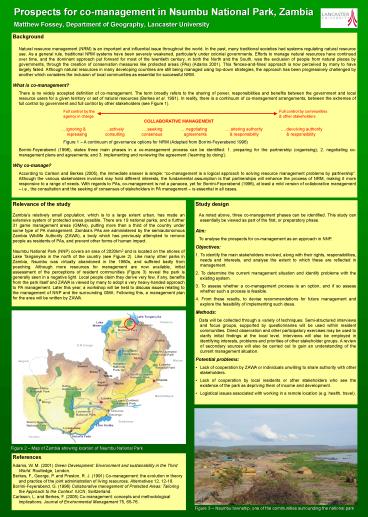Prospects for comanagement in Nsumbu National Park, Zambia PowerPoint PPT Presentation
1 / 1
Title: Prospects for comanagement in Nsumbu National Park, Zambia
1
- Prospects for co-management in Nsumbu National
Park, Zambia - Matthew Fossey, Department of Geography,
Lancaster University
Background Natural resource management (NRM) is
an important and influential issue throughout the
world. In the past, many traditional societies
had systems regulating natural resource use. As a
general rule, traditional NRM systems have been
severely weakened, particularly under colonial
governments. Efforts to manage natural resources
have continued over time, and the dominant
approach put forward for most of the twentieth
century, in both the North and the South, was the
exclusion of people from natural places by
governments, through the creation of conservation
measures like protected areas (PAs) (Adams 2001).
This fences-and-fines approach is now perceived
by many to have largely failed. Although natural
resources in many developing countries are still
being managed using top-down strategies, the
approach has been progressively challenged by
another which considers the inclusion of local
communities as essential for successful NRM.
What is co-management? There is no
widely accepted definition of co-management. The
term broadly refers to the sharing of power,
responsibilities and benefits between the
government and local resource users for a given
territory or set of natural resources (Berkes et
al. 1991). In reality, there is a continuum of
co-management arrangements, between the extremes
of full control by government and full control by
other stakeholders (see Figure 1). Full
control by the Full control by
communities agency in charge
other stakeholders
COLLABORATIVE MANAGEMENT
.ignoring .actively
.seeking
.negotiating .sharing authority
.devolving authority
repressing
consulting consensus
agreements responsibility
responsibility Figure 1
A continuum of governance options for NRM
(Adapted from Borrini-Feyerabend
1996) Borrini-Feyerabend (1996), states three
main phases in a co-management process can be
identified 1. preparing for the partnership
(organising) 2. negotiating co-management plans
and agreements and 3. implementing and reviewing
the agreement (learning by doing). Why
co-manage? According to Carlson and Berkes
(2005), the immediate answer is simple
co-management is a logical approach to solving
resource management problems by partnership.
Although the various stakeholders involved may
hold different interests, the fundamental
assumption is that partnerships will enhance the
process of NRM, making it more responsive to a
range of needs. With regards to PAs,
co-management is not a panacea, yet for
Borrini-Feyerabend (1996), at least a mild
version of collaborative management i.e., the
consultation and the seeking of consensus of
stakeholders in PA management is essential in
all cases.
Relevance of the study Zambias relatively small
population, which is to a large extent urban, has
made an extensive system of protected areas
possible. There are 19 national parks, and a
further 31 game management areas (GMAs), putting
more than a third of the country under some type
of PA management. Zambias PAs are administered
by the semiautonomous Zambia Wildlife Authority
(ZAWA), a body which has previously attempted to
remove people as residents of PAs, and prevent
other forms of human impact. Nsumbu National
Park (NNP) covers an area of 2020km2 and is
located on the shores of Lake Tanganyika in the
north of the country (see Figure 2). Like many
other parks in Zambia, Nsumbu was virtually
abandoned in the 1980s, and suffered badly from
poaching. Although more resources for management
are now available, initial assessment of the
perceptions of resident communities (Figure 3)
reveal the park is generally seen in a negative
light. Local people claim they derive very few,
if any, benefits from the park itself and ZAWA is
viewed by many to adopt a very heavy-handed
approach to PA management. Later this year, a
workshop will be held to discuss issues relating
to the management of NNP and the surrounding GMA.
Following this, a management plan for the area
will be written by ZAWA.
- Study design
- As noted above, three co-management phases can
be identified. This study can essentially be
viewed as part of the first, or preparatory
phase. - Aim
- To analyse the prospects for co-management as
an approach in NNP. - Objectives
- 1. To identify the main stakeholders involved,
along with their rights, responsibilities, needs
and interests, and analyse the extent to which
these are reflected in management. - 2. To determine the current management situation
and identify problems with the existing system. - 3. To assess whether a co-management process is
an option, and if so assess whether such a
process is feasible. - 4. From these results, to devise recommendations
for future management and explore the feasibility
of implementing such ideas. - Methods
- Data will be collected through a variety of
techniques. Semi-structured interviews and focus
groups, supported by questionnaires will be used
within resident communities. Direct observation
and other participatory exercises may be used to
clarify initial findings at the local level.
Interviews will also be employed in identifying
interests, problems and priorities of other
stakeholder groups. A review of secondary sources
will also be carried out to gain an understanding
of the current management situation. - Potential problems
- Lack of cooperation by ZAWA or individuals
unwilling to share authority with other
stakeholders. - Lack of cooperation by local residents or other
stakeholders who see the existence of the park as
depriving them of income and development. - Logistical issues associated with working in a
remote location (e.g. health, travel).
Figure 2 Map of Zambia showing location of
Nsumbu National Park
References Adams, W. M. (2001) Green
Development Environment and sustainability in
the Third World. Routledge, London. Berkes,
F., George, P. and Preston, R. J. (1991)
Co-management the evolution in theory and
practice of the joint administration of living
resources. Alternatives 12, 12-18. Borrini-Feyerab
end, G. (1996) Collaborative management of
Protected Areas Tailoring the Approach
to the Context. IUCN, Switzerland. Carlsson, L.
and Berkes, F. (2005) Co-management concepts and
methodological implications. Journal of
Environmental Management 75, 65-76.
Figure 3 Nsumbu township, one of the
communities surrounding the national park

